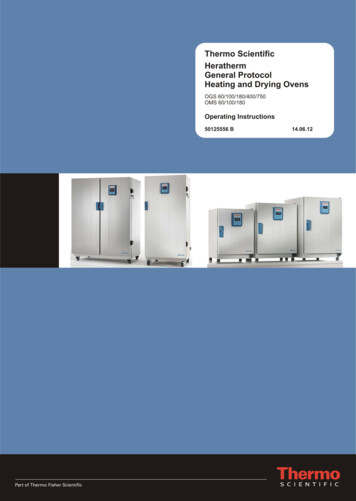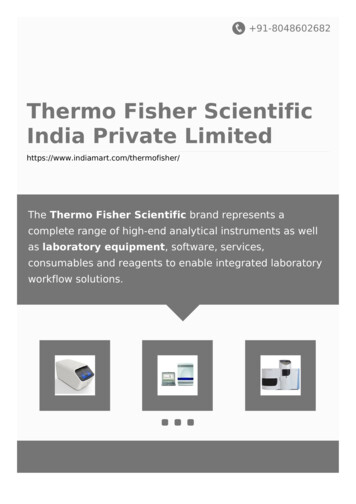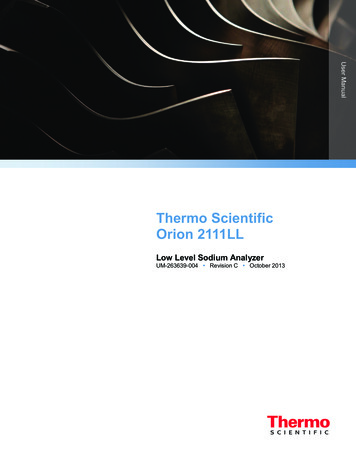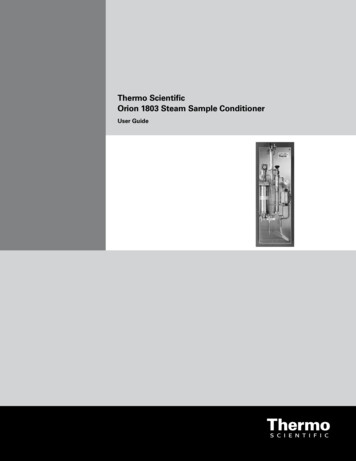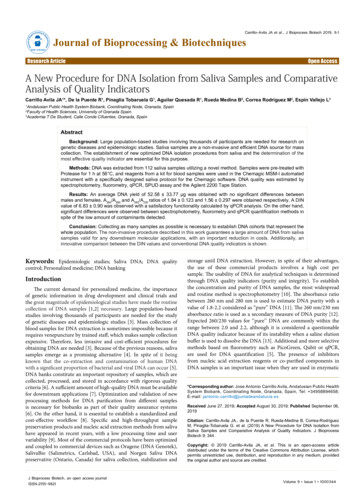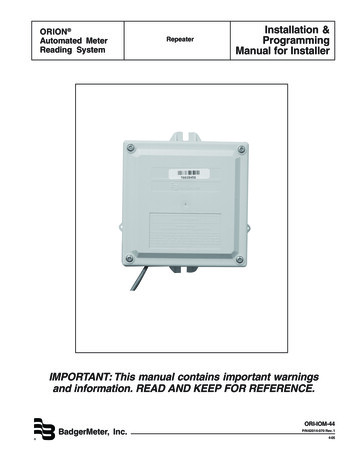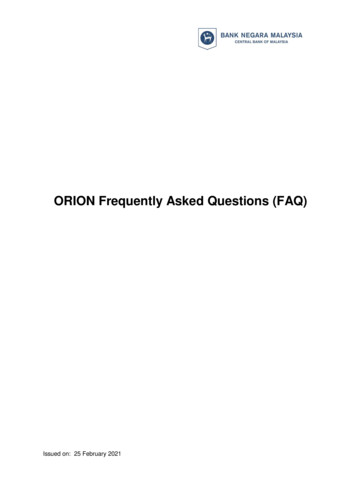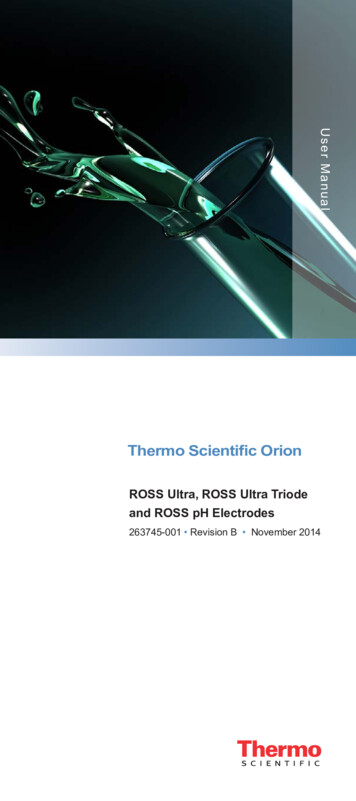
Transcription
U ser ManualThermo Scientific OrionROSS Ultra, ROSS Ultra Triodeand ROSS pH Electrodes263745-001 Revision B November 2014
ContentsIntroduction4ROSS Electrode Families4Required Equipment5Electrode Preparation6Sample Requirements8Measuring Hints9Electrode Calibration10pH Measurements12Electrode Storage12Electrode Maintenance12Electrode Cleaning Procedures12Electrode Characteristics13ROSS Ultra ElectrodesROSS Ultra pH/ATC Triode ElectrodesROSS ElectrodesROSS Sure-Flow ElectrodesROSS Semi-micro ElectrodesROSS micro pH ElectrodesPreparation for Refillable ROSS ElectrodesPreparation for ROSS Sure-Flow ElectrodesPreparation for Gel-Filled ROSS Ultra Triode ElectrodesGeneral Calibration ProcedureOne Buffer CalibrationTwo Buffer CalibrationGeneral CleaningCleaning SolutionsTemperature EffectsSure-Flow Electrode Leak RateROSS Micro pH ElectrodeROSS Ultra pH/ATC Triode Electrodes445555678101011121313141415ROSS Electrode Operation with Orion Versa Star pH/LogR Meters15Electrode ty18RoHS Statement18Ordering Information19Specifications21pH MeterElectrodeSample/ApplicationTechnique17171717
IntroductionThis user manual contains information on the preparation, operationand maintenance of the Thermo Scientific Orion ROSS Ultra ,Thermo Scientific Orion ROSS , and Thermo Scientific Orion ROSS Triode electrodes.All ROSS pH electrodes have a pH range of 0 to 14, pH precision of0.01 and temperature range of 0 to 100 C. ROSS electrodes can beused in samples that contain TRIS, sulfides and proteins since they donot contain silver or mercury.ROSS electrodes incorporate the distinctive ROSS internal referencesystem that provides superior measurement stability, faster response,greater accuracy and more reproducible results than conventionalelectrodes. ROSS electrodes have a double junction reference, sothe fill solution can be modified to more closely match the samplecomposition in high pH, low pH or non-aqueous solutions.ROSS electrodes provide readings stable to 0.01 pH in lessthan 30 seconds, even in the extreme case of samples varying fromone another by 50 C or more. Results are three to five times moreprecise than those obtained with conventional electrodes. Over thelifetime of the electrode, ROSS reference potential drifts less than anaverage 0.12mV per day, which corresponds to 0.002 pH units, sorecalibration is minimized. The majority of ROSS electrodes with a BNC waterproof or BNCconnector have a one meter (three foot) long cable, except wherenoted. All electrodes with a screw cap connection require a separate cable. Electrodes with a waterproof BNC connector can be used on any pHmeter with a BNC connection. The 800500U ROSS Ultra reference half-cell and 800300 ROSSreference half-cell can be used with the 8101BNWP and 8101SCROSS pH half-cell electrodes or 8411BN ROSS sodium half-cellelectrode.ROSS Electrode FamiliesROSS Ultra ElectrodesROSS Ultra electrodes offer the ultimate measurement stability and theleast long-term drift, plus a two year warranty for refillable models andan 18 month warranty for gel-filled models.ROSS Ultra pH/ATC Triode ElectrodesROSS Ultra pH/ATC Triodes have a built-in temperature probe,so pH and temperature are measured with one electrode.Gel-filled ROSS Ultra pH/ATC Triode electrodes have an 18 monthwarranty and refillable ROSS Ultra pH/ATC Triode electrodes have a 24month warranty.4 ROSS Ultra, ROSS Ultra Triode and ROSS pH ElectrodesThermo Scientific Orion
ROSS ElectrodesROSS electrodes provide precise pH measurements and measurementstability regardless of temperature changes or sample composition.ROSS Sure-Flow ElectrodesROSS Sure-Flow electrodes incorporate a free-flowing junction that iseasy to clean and never clogs. These electrodes are ideal for dirty orviscous samples that clog traditional electrodes.ROSS Semi-micro ElectrodesROSS semi-micro electrodes are designed for applications wheresample volume is limited and can take measurements in samples of 0.2ml volume. They are available with chemically-resistant glass (6 mmtip) or epoxy (8 mm tip) bodies, Sure-Flow junction and ROSS Ultralong-life models.ROSS micro pH ElectrodesROSS micro pH electrodes have been designed to measureextremely small samples. The measuring tip is 3 mm in diameter and40 mm long. The minimum depth of immersion is 4.5 mm and theminimum sample size is 15 μL in 384 well plates.Required Equipment1. Thermo Scientific Orion Versa Star , Thermo Scientific OrionStar A300 series, Thermo Scientific Orion Star A200 series,Thermo Scientific Orion Star A100 series or Thermo Scientific Orion Dual Star meter with pH measurement capability,such as the Versa Star benchtop meter with pH module, StarA211 pH benchtop meter or Star A321 pH portable meter;except 8107BNURCA, 8157BNURCA and 8302BNURCA Triodeelectrodes which are designed for use with a meters which supporta thermister with a 30K NTC curve and have an RCA plug, such asthe Five and Seven Series METTLER TOLEDO pH meters.ROSS electrodes can be used on any pH meter with a BNCconnection. The electrodes can also be used on meters witha variety of inputs when an adapter cable is used. Visit www.thermoscientific.com/water for details.2. Orion ROSS Ultra, and ROSS Triode electrodes. The 8302BNUMD, 8107BNUMD, 8107UWMMD, 8157BNUMDand 8157UWMMD pH/ATC Triode electrodes have atemperature connector that is compatible with Orion Star Aseries, Versa Star and Dual Star pH meters. The 8107BNURCA, 8157BNURCA and 8302BNURCA pH/ATC Triode electrodes have a temperature connector that iscompatible with meters which support a thermister with a 30KNTC curve and have an RCA plug, such as the Five and SevenSeries METTLER TOLEDO pH meters.3. ROSS fill solution, Cat. No. 810007.Note: Do not use any fill solution that contains silver, as silverwill damage ROSS electrodes.Thermo Scientific OrionROSS Ultra, ROSS Ultra Triode and ROSS pH Electrodes 5
Note: The 8107BNUMD, 8107UWMMD and 8107BNURCAelectrodes are gel-filled and do not require any fill solution.4. ROSS pH electrode storage solution, Cat. No. 810001, or standardpH electrode storage solution, Cat. No. 910001. For enhancedelectrode performance, use ROSS pH electrode storage solution.5. pH buffers – at least two pH buffers are recommended for precisemeasurements. One buffer should be near pH 7 and buffers shouldbe one to four pH units apart.6. Beakers, plastic or glass.7. Magnetic stirrer or Orion stirrer probe, Cat. No. 096019. The stirrerprobe can be used with Orion Star A series, Versa Star and DualStar benchtop meters.8. Distilled or deionized water.Electrode PreparationPreparation for Refillable ROSS Electrodes1. Remove the shipping cap, sleeve or bottle from the sensing bulband save it for later storage of the electrode.2. Clean any salt deposits from the exterior of the electrode by rinsingit with distilled water. Handle the 8220BNWP ROSS micro pHelectrode with great care.3. The electrode may arrive with the chamber partially filled withelectrolyte solution. Please fill the chamber with electrolyte solutionbefore use. Uncover the fill hole by removing the tape and addROSS fill solution, Cat. No. 810007, to the electrode up to the fillhole. To maintain an adequate flow rate, the level of fill solutionmust always be above the reference junction and at least one inchabove the sample level. The fill hole should remain open wheneverthe electrode is in use.4. Place the electrode in an electrode holder and suspend theelectrode in air for 5 minutes to thoroughly wet the referencejunction. Omit this step for electrodes which come shipped in astorage bottle.5. Shake the electrode downward (similar to a clinical thermometer)to remove any air bubbles. The 8220BNWP electrode is extremelyfragile. Do not shake the 8220BNWP electrode unless there areair bubbles in the fill solution and then shake gently and with greatcare.6. Soak electrode in ROSS pH electrode storage solution,Cat. No. 810001, or standard pH electrode storage solution, Cat.No. 910001, for 30 to 60 minutes. ROSS Ultra Triode electrodesdo not need to be soaked prior to use, since they are shipped in astorage bottle with storage solution.7. Connect the electrode to the meter.6 ROSS Ultra, ROSS Ultra Triode and ROSS pH ElectrodesThermo Scientific Orion
Fill ncejunctionpH sensingbulbROSS Refillable Combination pH ElectrodePreparation for ROSS Sure-Flow Electrodes1. Remove the shipping cap, sleeve or bottle from the sensing bulband save it for later storage of the electrode.2. Clean any salt deposits from the exterior of the electrode by rinsingit with distilled water.3. Uncover the fill hole by removing the tape and add ROSS fillsolution, Cat. No. 810007, to the electrode up to the fill hole. ToFill holemaintain an adequate flow rate, the level of fill solution must alwaysbeabove the reference junction and at least one inch above theFill holesample level. The fill hole should remain open whenever theelectrode is in use. Fill solutionROSSinternalchamber4. Wetreferencethe junction by pressingdown on the electrode cap to let a fewFillsolutiondropsof the ROSS fillsolution flow out of the electrode and thenSure-FlowROSSchamberreferencepH sensingany lost fill solution.internalreplenishjunctionreferencebulb5. Shake the electrodeReferencedownward (similar to a clinical thermometer) tojunctionremove any air bubbles.pH sensingbulb6. Soak electrode in ROSS pH electrode storage solution, Cat.No. 810001, or standard pH electrode storage solution, Cat.No. 910001, for 30 to 60 minutes. For enhanced electrodeperformance, use ROSS pH electrode storage solution.7. Connect the electrode to the meter.Fill holeROSSinternalreferencepH sensingbulbThermo Scientific OrionFill solutionchamberSure-FlowreferencejunctionROSS Ultra, ROSS Ultra Triode and ROSS pH Electrodes 7
Preparation for Gel-Filled ROSS Ultra TriodeElectrodes1. Remove the electrode storage bottle from the sensing bulb andsave it for later storage of the electrode.Note: Unscrew the cap on the electrode storage bottle beforeremoving the electrode.2. Clean any salt deposits from the exterior of the electrode by rinsingit with distilled water.3. Connect the electrode to the meter.4. If the electrode will not be used immediately, soak it in ROSSpH electrode storage solution, Cat. No. 810001, or standard pHelectrode storage solution, Cat. No. 910001.ROSS Gel-filled Combination pHElectrodeROSSinternalreferenceGel solutionchamberReference junctionpH sensing bulbSample RequirementsA benefit of the ROSS pH electrodes is that the fill solution compositionmay be changed depending on the sample requirements. The ROSSpH electrode fill solution, Cat. No. 810007, is 3 M KCl. For solutionsthat precipitate in the presence of chloride ions, the electrode can befilled with 10% KNO3, Cat. No. 900003.Electrodes with an epoxy body should only be used in aqueoussolutions.Electrodes with a glass body may be used in non-aqueous solutionsand solutions that contain organic solvents. A minimum of 20% watermust be present in the sample for the best measurement results. Ifthere is a great deal of drift when using the ROSS electrode filled withROSS fill solution, try filling the electrode with a mixture of methanol8 ROSS Ultra, ROSS Ultra Triode and ROSS pH ElectrodesThermo Scientific Orion
and water saturated with KCl. The ratio of methanol to water should besimilar to the sample composition. For tips on measuring pH in nonaqueous samples, see Thermo Scientific Water Analysis InstrumentsApplication Note 007.If using the 8220BNWP ROSS micro pH electrode, great care mustbe taken to thoroughly rinse out the reference chamber and junctionbefore changing the reference solutions.Measuring Hints Always use fresh buffers for calibration. Choose buffers that are oneto four pH units apart. Check the electrode slope daily by performing a two buffercalibration. The slope should be 92 to 102%. Except as noted in the Sample Requirements section, only useROSS fill solution, Cat. No. 810007. Do not use any fill solution thatmay contain silver. If a refillable electrode is used, always remove the fill hole coverduring measurements to ensure a uniform flow of fill solution. If a ROSS Ultra Triode is used, immerse the electrode at least 2inches (5 cm) in solution for best temperature response. Between measurements, rinse the electrode with distilled water andthen with the next solution to be measured. Stir all buffers and samples at a uniform rate. Place a piece of insulating material, such as polystyrene foam orcardboard, between the magnetic stir plate and beaker to preventmeasurement errors from the transfer of heat to the sample. SinceROSS electrodes respond quickly to temperature changes, pHchanges due to temperature variations will be noticed. To reduce the chance of error due to polarization, avoid rubbing orwiping the sensing bulb. Use a lint-free tissue and gently blot thesensing bulb. If a refillable electrode is used in dirty or viscous samples orthe electrode response becomes sluggish, empty the electrodecompletely and hold the junction under running water. Empty anywater from the electrode and refill it with fresh ROSS fill solution.For a thorough cleaning method, refer to the Electrode CleaningProcedures section. If a Sure-Flow electrode is used in dirty or viscous samples orthe electrode response becomes sluggish, empty the electrodecompletely and hold the junction open under running water. Emptyany water from the electrode and refill it with fresh ROSS fillsolution. Press down on the electrode cap to let a few drops of theROSS fill solution flow out of the electrode and then replenish anylost solution. For a thorough cleaning method, refer to the ElectrodeCleaning Procedures section. Handle the 8220BNWP ROSS micro pH electrode with care. Donot touch the pH bulb and stem against the bottom or walls of thesample containers.Thermo Scientific OrionROSS Ultra, ROSS Ultra Triode and ROSS pH Electrodes 9
Filling hole shouldbe uncoveredFilling solution levelmust be higher thansample levelReference junctionmust be immersedFresh pH bufferPlace insulationbetween stirrerand beakerStir all samplesand buffersMeasuring Hints Flat surface ROSS pH electrodes may be used on anymoist surface or in liquids.Using a Flat Surface ElectrodeElectrode CalibrationGeneral Calibration ProcedureFor detailed instructions on pH calibration, manual pH calibration andtemperature compensation, consult your meter user guide. Whenusing ROSS electrodes with a Versa Star pH/LogR meter, refer to theVersa Star pH/LogR meter user guide for instructions on temperaturecalibration and LogR temperature compensated pH measurements.Note: If the meter is set to automatically recognize the pH buffer at themeasured temperature and an ATC probe is used, you do not need tomanually adjust the pH values of the buffers.One Buffer Calibration1. Choose a buffer near expected sample pH.2. The buffer should be at same temperature as the sample. If thebuffer and samples are at varying temperatures, temperaturecompensation is recommended.3. Prepare the meter according to the meter user guide.4. Rinse the electrode first with distilled water and then with the bufferbeing used for calibration.10 ROSS Ultra, ROSS Ultra Triode and ROSS pH ElectrodesThermo Scientific Orion
5. Place the electrode into the buffer. When the reading is stable,set the meter to the pH value of the buffer at the measuredtemperature. Refer to the meter user guide for a detailedprocedure. Table 1 provides pH buffer values at varioustemperatures.6. Proceed to the pH Measurement section.Two Buffer CalibrationThis procedure is recommended for precise measurements.1. Select two buffers that bracket the expected sample pH. The firstbuffer should be near the electrode isopotential point (pH 7) andthe second should be near the expected sample pH (pH 4 or pH10). Buffers should be one to four pH units apart.2. The buffers should be at same temperature as the sample. If thebuffers and samples are at varying temperatures, temperaturecompensation is recommended.3. Rinse the electrode first with distilled water and then with the firstbuffer.4. Place the electrode into the first buffer. When the reading isstable, set the meter to the pH value of the buffer at the measuredtemperature. Refer to the meter user guide for a detailedprocedure. Table 1 provides pH values at various temperatures.5. Rinse the electrode first with distilled water and then with thesecond buffer.6. Place the electrode into the second buffer. When the readingis stable, set the meter to the pH value of the buffer at themeasured temperature. Refer to the meter user guide for adetailed procedure. Table 1 provides pH buffer values at varioustemperatures.90 C80 C70 C60 C50 C40 C30 C20 C10 C5 CTemperature0 CNominalBufferValue at25 C1.681.67 1.67 1.67 1.68 1.68 1.69 1.71 1.72 1.74 1.77 1.794.014.00 4.00 4.00 4.00 4.02 4.03 4.06 4.09 4.12 4.16 4.216.866.98 6.95 6.92 6.87 6.85 4.03 6.83 6.84 6.85 6.86 6.887.007.11 7.08 7.06 7.01 6.98 6.97 6.96 6.97 6.99 7.03 7.089.189.46 9.40 9.33 9.23 9.14 9.07 9.01 8.96 8.92 8.89 8.8510.0110.32 10.25 10.18 10.06 9.97 9.89 9.83 9.79 9.78 9.78 9.8012.4613.47 13.24 13.03 12.64 12.29 11.99 11.73 11.50 11.30 11.13 11.98Table 1: pH Values of Buffers at Various TemperaturesThermo Scientific OrionROSS Ultra, ROSS Ultra Triode and ROSS pH Electrodes 11
pH Measurements1. Calibrate the electrode as described in the Electrode Calibrationsection.2. Rinse the electrode with distilled water and then with the sample.3. Place the electrode into the sample.4. When the reading is stable, record the pH and temperature of thesample.Electrode StorageTo ensure a quick response and free flowing junction, the sensing bulband reference junction must not dry out.Short Term Storage (up to one week)Soak the electrode in ROSS pH electrode storage solution, Cat. No.810001, or standard pH electrode storage solution, Cat. No. 910001.For enhanced electrode performance, use ROSS pH electrode storagesolution.To minimize the chance of breakage, the 8220BNWP ROSS micro pHelectrode should be attached to an electrode stand and suspended ina beaker that contains storage solution. The electrode should not touchthe side or bottom of the beaker.Long Term Storage (more than one week)For refillable pH electrodes, fill the reference chamber and securelycover the fill hole. Cover the sensing bulb and reference junction withthe protective cap, sleeve or storage bottle containing a few drops ofstorage solution. Before returning the electrode to use, prepare it as anew electrode.Electrode Maintenance1. Inspect the electrode for scratches, cracks, salt crystalbuildup or membrane/junction deposits.2. Rinse off any salt buildup with distilled water. Remove anymembrane/junction deposits as directed in the General Cleaningsection.3. If a refillable electrode is used, drain the reference chamber, flushit with fresh ROSS fill solution and refill the chamber with freshROSS fill solution.Electrode Cleaning ProceduresGeneral CleaningWe offer a variety of Orion pH cleaning solutions for your convenience,including solutions for general cleaning, protein removal, bacteriaremoval, and oil and grease removal. See the list of Orion cleaningsolutions below the General Cleaning section of this manual. If youwould like to prepare your own cleaning solutions, the general cleaningprocedures contain several recommendations.12 ROSS Ultra, ROSS Ultra Triode and ROSS pH ElectrodesThermo Scientific Orion
1.a. For general cleaning, prepare a 0.1 M hydrochloric acid (HCl)or 0.1 M nitric acid (HNO3) solution.b. For cleaning oil or grease, prepare a 0.1 to 0.5 % liquiddetergent solution mixed with hot water.c. For cleaning bacterial contaminants, prepare a 1:10 dilution ofhousehold laundry bleach.2.a. Soak the electrode in the 0.1 M HCl or HNO3 for half an hourand stir the solution at a moderate rate.b. Soak the electrode in the 1:10 dilution of household laundrybleach or the 0.1 to 0.5% liquid detergent solution mixed withhot water for 15 minutes and stir the solution at a moderaterate.3. If a refillable electrode is used, drain the reference chamber andrefill the electrode with fresh ROSS fill solution.4. Soak the electrode in ROSS pH electrode storage solution, Cat.No. 810001, or standard pH electrode storage solution, Cat. No.910001, for at least one hour.Cleaning SolutionsCat. No. 900021-WA: pH cleaning solution A for removing proteincontaminants.Cat. No. 900022-WA: pH cleaning solution B for removing bacterialcontaminants.Cat. No. 900023: pH cleaning solution C for general cleaning.Cat. No. 900024: pH cleaning solution D for removing oil and greasecontaminants.Cat. No. 900020: pH cleaning solution kit, includes cleaning solutionsA, B, C and D.Electrode CharacteristicsTemperature EffectsThe most common cause of error in pH measurements is temperature.There are at least five ways that temperature variations can affectpH: electrode slope, buffers, samples, reference element drift, andtemperature sensor errors.Electrode Slope ChangesThe electrode slope will change with variations in temperature.Slope changes may be compensated manually, automatically withan automatic temperature compensation (ATC) probe or with LogRtechnology using a LogR enabled meter and any Orion electrode.Thermo Scientific Orion pH meters calculate the slope based on themeasured temperature and automatically adjust the pH value based onthe temperature.Thermo Scientific OrionROSS Ultra, ROSS Ultra Triode and ROSS pH Electrodes 13
Buffer and Sample pH ChangesBuffer and sample pH values change with temperature because oftheir temperature dependent chemical equilibria. The pH electrodeshould be calibrated with buffers that have known pH values at differenttemperatures. Buffer values at different temperatures are given inTable 1.Orion pH meters automatically calibrate with the correct pH buffervalues based on the measured temperature. All pH meters are unableto correct sample pH values back to a reference temperature becauseevery sample has a unique pH value versus temperature relationship.Therefore, calibration and measurements should be performed at thesame temperature and pH values should be reported with temperature.Reference Element DriftDrift can occur when the internal reference elements inside the pH andreference portions of the electrode are reaching thermal equilibriumafter a temperature change. Long-term drift or slow response can lastuntil the sample and electrode are at the same temperature.ROSS electrodes use a unique internal reference to minimize theequilibration time.Temperature Sensor ErrorsWhen a pH and ATC probe are placed into a sample that variessignificantly in temperature, the readings can drift for two reasons. First,the temperature response of the electrode and temperature probe maynot be similar, which prolongs equilibration and drift. Second, a samplemay not have a uniform temperature. Therefore, the pH electrode andtemperature probe are responding to different environments. Stirringthe sample will minimize this effect.Using LogR technology, Orion Versa Star and Orion Dual Starmeters calculate the temperature by measuring the resistance valueof the ROSS pH electrode’s sensing bulb. The pH and temperatureresponse is identical and both measurements occur at the sensingbulb. Drift is minimized and errors due to environmental differences areeliminated.Sure-Flow Electrode Leak RateThe junction of the ROSS Sure-Flow electrodes has been designedto leak at a rate of approximately 1 mL per 24 hours. To keep thejunction from clogging, the leak rate is slightly higher than conventionalelectrodes. During the average pH measurement time the loss offill solution is minimal and the fill solution does not contaminate thesample.ROSS Micro pH ElectrodeThe 8220BNWP ROSS micro pH electrode has been designed tomeasure extremely small samples. The measuring tip is 3 mm indiameter and 40 mm long. The minimum depth of immersion is 4.5 mmand the minimum sample size is 15 µL in 384 well plates.14 ROSS Ultra, ROSS Ultra Triode and ROSS pH ElectrodesThermo Scientific Orion
ROSS Ultra pH/ATC Triode ElectrodesThe ROSS Ultra Triode electrode operating temperature range is 0to 100 C and the temperature accuracy is 1 C at 2 minutes whenimmersed at least 2 inches in solution. The temperature equilibrationdue to the rate of heat transfer can take up to 2 minutes in a stirred,aqueous solution.ROSS Electrode Operation withOrion Versa Star pH/LogR MetersWhen ROSS electrodes are used with Orion Versa Star pH/LogRMeters, enhanced temperature compensation is achieved withoutthe need of a separate ATC probe. Using LogR technology, thetemperature of the solution is measured through the resistance value ofthe pH electrode’s sensing bulb.Each ROSS pH electrode must be calibrated for temperature beforea pH measurement is performed using LogR technology. Refer to theOrion Versa Star pH/LogR meter user guide for details. For maximumprecision, a three point temperature calibration is recommended. Donot perform a one point temperature calibration if measured solutionswill be below 20 C. The following tables illustrate the expectedpH compensation error for one, two and three point temperaturecalibrations. The accuracy values are valid only when the temperaturecalibration is performed within the stated temperature range. Thehigher temperature range data will apply to measurements made abovethat temperature range, provided that calibration points are within 20 Cof each other. When highly accurate pH results are desired, a separateATC probe is recommended.One Point Temperature eTemp. Error20-30 C0.130.240.910.09AverageTemp. Error30-50 C0.070.170.950.10AveragepH Error20-30 C0.0020.0030.0110.001AveragepH Error30-50 C0.0010.0020.0110.001Two Point Temperature etemp. error0-25 C0.130.240.910.09Thermo Scientific OrionAveragetemp. error20-40 C0.070.170.950.10AveragepH error0-25 C0.0020.0030.0110.001AveragepH error20-40 C0.0010.0020.0110.001ROSS Ultra, ROSS Ultra Triode and ROSS pH Electrodes 15
Three Point Temperature etemp. error0-25 C0.040.040.070.04Averagetemp. error20-40 C0.030.010.060.06AveragepH error0-25 C0.0000.0000.0010.000AveragepH error20-40 C0.0000.0000.0010.001Electrode InterferencesSodium ions are the principal interference of the pH electrode andcause increasing error at higher pH (lower hydrogen ion activities) andat higher temperatures. Because the pH membrane is composed ofspecial low sodium error glass, error due to sodium is negligible whenmeasuring at pH values less than 12. When measuring at pH valuesgreater than 12, add the correction value from the nomograph below tothe observed pH reading.SamplepH reading C 20pH correctionto be added0.1 M2530130.5 20.03705M80300.1 M1120 C25400.5 00.400.500.600.705MTypical Sodium ErrorExample:pH reading:Sodium concentration:Temperature:Correction:Corrected pH reading:12.100.5 M50 C0.0112.1116 ROSS Ultra, ROSS Ultra Triode and ROSS pH ElectrodesThermo Scientific Orion
TroubleshootingFollow a systematic procedure to isolate the problem. The pHmeasuring system can be divided into four components: pH meter,electrode, sample/application and technique.pH MeterThe meter is the easiest component to eliminate as a possible cause oferror. Orion pH meters include an instrument checkout procedure andshorting cap for convenience in troubleshooting. Refer to the pH meteruser guide for directions.ElectrodeTo test electrode operation:1. Connect the electrode to a working meter that has a mV measuringmode. Set the meter to the mV mode.2. Rinse the electrode with distilled water and then insert theelectrode into fresh pH 7 buffer. When the reading is stable, recordthe mV value of the pH 7 buffer. The mV value should be in therange of -30 to 30 mV.3. Rinse the electrode with distilled water and then insert theelectrode into fresh pH 4 buffer. When the reading is stable, recordthe mV value of the pH 4 buffer. The mV value should be in therange of 150 to 210 mV.4. Calculate the absolute mV difference between the two buffers. ThemV difference should be 160 to 180 mV. The actual mV values willchange as the electrode ages, but the mV difference between thetwo buffers should always be 160 to 180 mV.5. If the electrode fails this procedure, clean the electrode thoroughlyas directed in the Electrode Maintenance section and repeat theprocedure.If the electrode response is slow or drifting and the electrode isrefillable, drain and refill the electrode with fresh ROSS fill solution, Cat.No. 810007.Replace the electrode if cleaning and maintenance fail to rejuvenate it.Sample/ApplicationThe electrode and meter may operate with buffers, but not with thesample. In this case, check the sample composition for interferences,incompatibilities or temperature effects. Refer to the Interferencessection.TechniqueIf trouble persists, review operating procedures. Review the calibrationand measurement sections to be sure proper technique has beenfollowed.Thermo Scientific OrionROSS Ultra, ROSS Ultra Triode and ROSS pH Electrodes 17
AssistanceAfter troubleshooting all components of your measurement system,contact Technical Support. Within the United States and Canada, call1.800.225.1480 or 978.232.6000 or emailwai.techservbev@thermofisher.com. For countries outside of NorthAmerica, contact your local authorized dealer.WarrantyFor the most current warranty information, visitwww.thermoscientific.com/WaterWarrantyRoHS Statement部件名称Part Name有毒或有害物质和元素Toxic or Hazardous Substances and Elements铅 Lead (Pb)汞 Mercury (Hg)镉 Cadmium (Cd)传感器体带电缆装配Sensor b
extremely small samples. The measuring tip is 3 mm in diameter and 40 mm long. The minimum depth of immersion is 4.5 mm and the minimum sample size is 15 μL in 384 well plates. Required Equipment 1. Thermo Scientific Orion Versa star , Thermo Scientific Orion Star A300 series, Thermo Scientific Orion Star A200 series,
